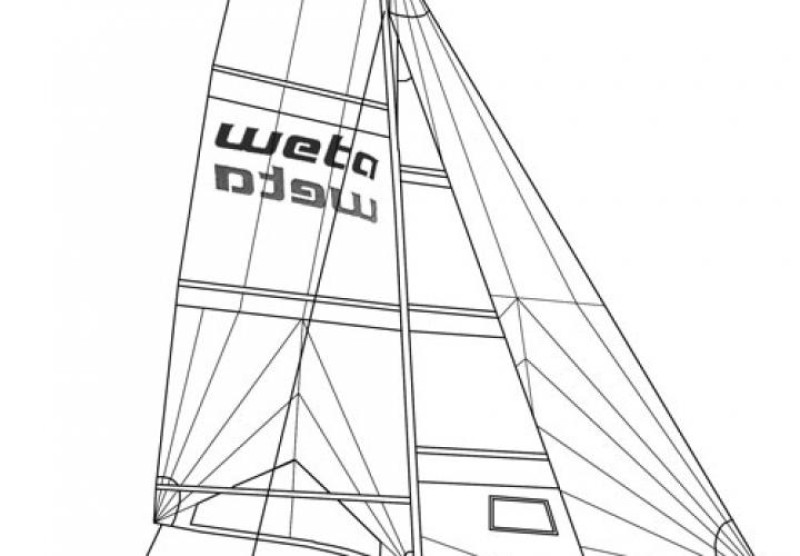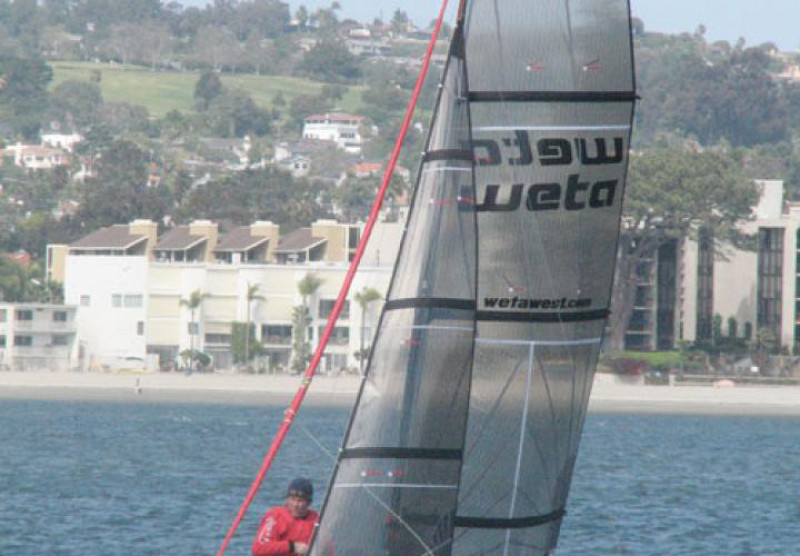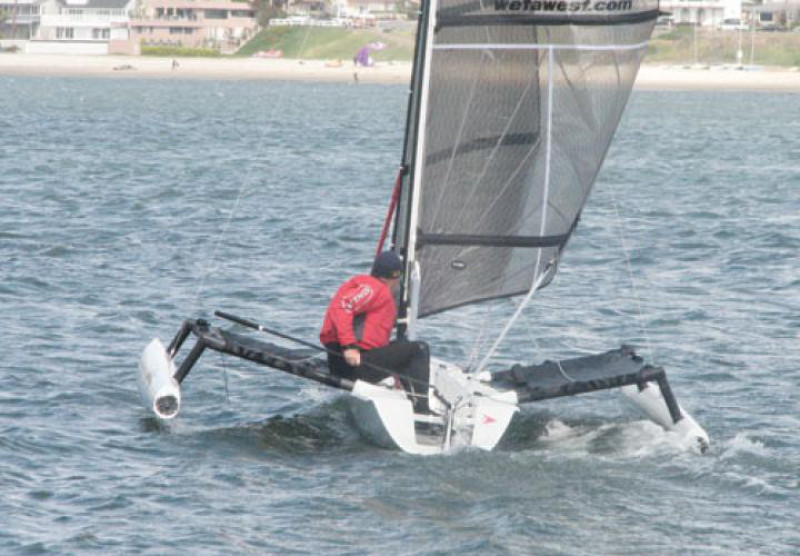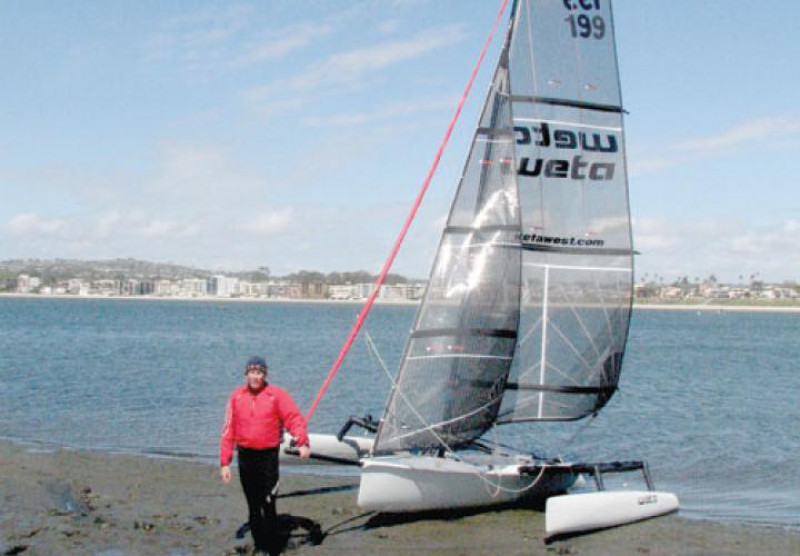
June 07th, 2010
The name weta refers to a family of large insects in the New Zealand Archipelago. Roughly translated, weta means "God of ugly things." Nothing could be farther from the truth about the insect's namesake, a sexy 14-foot trimaran called the Weta that has been turning heads like crazy.
Designed and built by Weta Marine of New Zealand, the Weta made its debut in 2007. Since then this new-kid-on-the-block of small multihull designs has been frequenting boat shows in France, England, Sweden, the Netherlands and China, drumming up a strong following at every stop.
Multihull sailing has come a long way since Woody Brown's first Hawaiian catamarans of the 1950s. Those early boats were based on ancient Polynesian outrigger designs, but their speed and grace in a variety of situations captured the imagination of a couple of young surfers named Hobie Alter and Phil Edwards. That partnership created the Hobie Cat and the rest is history.
That first 14-foot Hobie Cat has inspired generation after generation of new boat designers. While the basics of the catamaran have remained the same, a multitude of advancements and alterations have ensued, all in search of a better formula for speed, excitement, ease of transport and comfort. That simple quotient could not be more clearly defined or more successfully marketed than in the Weta. This light and responsive trimaran with collapsible amas just might be what the boating market needs.
Last spring, a demonstration of the Weta was held on a beach near the Mission Bay Yacht Club on an overcast but gusty day in San Diego. As a storm blew through, it crossed my mind that this was anything but the right day to try what I anticipated would be a flimsy, high-tech, wet boat. When I pulled up there were people lining the shore to get a glimpse of this unusual-looking craft. There were multihull racers, Laser sailors, big boat veterans and young fathers looking for something the entire family could enjoy.
The one-design racers confirmed the Weta to be responsive in a variety of conditions, while the big-boat sailors were impressed their body weight in 20 knots of wind did nothing to deter the boat's performance. Perhaps the best response, however, came from 9-year-old Andrew Fleming, who summed up the adventure succinctly: "If this were a report card, I'd give it an A-plus."
Andrew's father was no less impressed. "I've sailed one-designs for most of my life," said Bruce Fleming. "Then my kids came along and I gave up sailing. The Weta is exactly what I've been looking for-a boat that is small and responsive, and that I can singlehand, but also a boat my entire family can sail and enjoy."
Fleming's description was spot on. This is a boat that can make the hair on the back of your neck stand up in certain conditions, and yet it's a stable enough platform for the entire family to enjoy. The Weta can carry three adults with ease. Of course, the power-to-weight ratio is reduced under such a load, but in a breeze she still gets up and goes.
At the same time Weta was holding its trials, the San Diego NOOD Regatta cancelled racing when a vicious weather front blew across the course. For a time winds were gusting at 30 knots. This didn't deter Simon Garland and Jeff Westbrook, big-boat sailors eager to try the Weta. They figured they would easily handle the small boat. As they sailed around Mission Bay it didn't take long for them to trim aft in the cockpit and grow competent in setting the reaching jib, called the "screecher." Even though both men were six feet tall, with a combined weight of 400 pounds, the Weta managed to get a hull out of the water several times.
The boat is very forgiving and actually very difficult to capsize, but it can happen. Garland and Westbrook were surprised by a gust and lost the boat at one point, finding themselves in the water and struggling to right an unfamiliar boat. Unlike the Hobie, Prindle and other larger multihulls, the Weta has a no-nonsense process for righting the trimaran that a child could execute. Even a turtled Weta won't give most sailors too much trouble.
The system is simple: Stand on one of the outer pontoons and unscrew the inspection port at the back of the hull until it fills with water. The sinking pontoon will turn the boat over. As you sail away the water drains from the outer hull. Unfortunately, the backing plate doesn't float, and when you right a boat like this in a stiff breeze, you really don't want to have an inspection port lid in your hand. Fortunately the designers have addressed this problem by attaching a retaining line to the cover. Problem solved.
Garland and Westbrook were not deterred. "She's very touchy, very responsive," Westbrook said. "What we noticed was that she really took. We had a variety of wind conditions out there today and the boat was marvelous in every one of them. Our problem was that we were really pushing her when we were surprised by a pretty big gust. We were going to weather and had the mainsheet too tight. The leeward hull started to sink and over we went, very slowly.
"Sensitive? Yes, and especially in winds like we had today, but we really enjoyed sailing her. The little trimaran has the feel of a real boat. When you consider our combined weight, the wind, and how hard we pushed her today it's pretty amazing that we didn't break anything. That says a lot about a boat."
The day before the storm blew through I had the chance to sail the Weta in lighter air. I, too, found the boat to be extremely responsive; able to accelerate rapidly and sharp in the turns. Being able to lie out on the hiking aprons gives you a chance to really appreciate the shape of your sails, and the forward daggerboard makes all the difference in the world. While all multihulls seem to want to break the sound barrier off the wind, most are slow and cumbersome in tacks. The Weta turns on a dime. How refreshing that is to discover. The daggerboard can be pulled up for downwind sailing or beaching the boat, and the kick-up rudder allows for smooth beach assaults.
One problem I encountered was a wrapping of the small staysail when jibing. In the end I determined it was the rookie reviewer driving the boat, and not a gear malfunction. I was releasing the jib too late. A little practice and a forgiving breeze improved my timing rapidly.
The cockpit is smartly designed with lots of room and an open transom. The tiller is long, allowing the driver to work the front of the boat. As Garland and Westbrook discovered, in a good blow, and with excessive weight in the boat, you need to move aft to trim the load. The boomless main is extremely comfortable to use in all conditions. The fully battened jib carries a great shape. The roller furling screecher has a welcome demystifying effect on whoever is driving the boat. Surprisingly, it was very simple to use.
It's really hard to find fault with this compact little racer. It sails fast without a lot of drama or preparation in the cockpit. Yes, it could find a future as a popular one-design but I predict the real audience will be flat-water sailors (lakes and bays) and families. This is a powerful little boat, and yet, even in a good blow the sails are quiet and sail area can be reduced to make the boat more manageable.
The Weta only takes 20 minutes to rig and has just five lines controlling all three sails. The two-piece mast is easy to step, and an optional pivoting mast base allows the mast to be simply folded down instead of unstepped. The outer hulls fold inward on hinged amas, nesting and tucking to make a trailerable load no wider than a Laser-a plus on the road and in storing out of the water.
The Weta really is an incredibly fun boat in most any wind. It sails like a dinghy and is very well balanced. One person described it as a dinghy with training wheels. Not a flattering description, but visually it gets the point across. I had a chance to sail alongside Lasers and pocket cruisers. I gave them both good leads and then made my move. There is an ageless thrill that comes with having a faster boat. There was no contest in the light air of Mission Bay, and a couple of times I actually fell backwards as the boat accelerated.
The Weta hulls are a solid fiberglass laminate. A foam sandwich laminate is used on the main deck for added strength. All the boat's components are vacuum bagged (even the frames) and vinylester resin is used to enhance strength and rigidity. The mast, beams and tiller extension are carbon fiber. The deck gear is mostly Harken. As stated, the boat is smartly rigged although some sailors are modifying the cockpit with ratchet blocks, swivel cleats and stainless bridles.
The sails are by Gaastra, and the main and jib are made from transparent laminated Mylar cloth, which makes it easy to see leeward traffic. The screecher is made from a high-quality, non-stretch spinnaker cloth and comes in a variety of colors.
The Weta measures in at 14 feet, 5 inches in length, and 11 feet, 6 inches in the beam fully extended. On the trailer it's an entirely different story, as the boat tucks into 5 feet, 7 inches. The total dry weight of the boat is 211 pounds with a mast weight of 9 pounds. The Weta can carry 440 pounds and has been clocked at 18.6 mph. There is 123 square feet of area in the main and jib, and 86 more square feet in the screecher. This boat will add a fresh new dimension to sailing for a variety of sailors.


